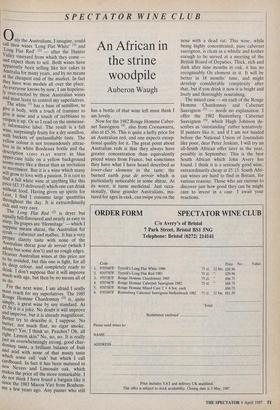SPECTATOR WINE CLUB
An African in the strine woodpile
Auberon Waugh
Only the Australians, I iniagine, could call their wines 'Long Flat White' (1) and 'Long Flat Red' (2) — after the Hunter Valley vineyard from which they come and expect them to sell. Both wines have apparently been selling like hot cakes in Australia for many years, and by no means at the cheapest end of the market. In fact they have won medals all over the place. As everyone knows by now, I am hopeless- ly over-excited by these Australian wines and must learn to control my superlatives. The white (1) has a base of semillon, to give it body, with a touch of traminer to give it nose and a touch of trebbiano to aspen it up. Or so I read on the immense- ly Informative label. The result is a . full wine, surprisingly fruity for a dry semillon, with buckets of unclassifiable taste. The Yellow colour is not tremendously attrac- tive in its white Bordeaux bottle and the (lescriptiOn LONG FLAT WHITE in blue uPPer-ease italic on a yellow background seems more like a threat than an invitation to merriment. But it is a wine which many will grow to love with a passion. It is rare to find a full white wine at anything like this Price (£3.33 delivered) which one can drink without food. Having given up spirits for Lent, I find I consume large quantities throughout the day. It is extraordinarily rich and very easy. The Long Flat Red (2) is dryer but equally full-flavoured and nearly as easy to slurp. Its grapes are 'Hermitage' — which I suppose means shiraz, the Australian for syrah — cabernet and malbec. It has a very Proper clarety taste with none of the Australian shiraz gout de terroir (which I adore but some don't) and no rough edges. Heavier Australian wines at this price are to be avoided, but this one is light, for all its deep colour, and completely ready to drink. I don't suppose that it will improve much with age, but then by no means all of us do.
For the next wine, I am afraid I really must reach for my superlatives. The 1985 Rouge Homme Chardonnay (3) is, quite simply, a great wine by any standard. At f-5.56 it is a joke. No doubt it will improve and improve, but it is already magnificent. Better try to describe it, I suppose. No butter, not much flint, no cigar smoke. Honey? Yes, I think so. Peaches? Oh, all light. Lemon skin? No, no, no. It is really just an overwhelmingly strong, good char- donnay taste, a brilliant balance of fruit and acid with none of that musty taste which some call 'oak' but which I call cardboard. In fact it has been matured in new Nevers and Limousin oak, which makes the price all the more remarkable. I do not think I have found a bargain like it since the 1983 Macon Vire from Bonhom- me a few years ago. Any punter who still has a bottle of that wine left must think I am lovely.
Now for the 1982 Rouge Homme Caber- net Sauvignon (4), also from Coonawarra, also at £5.56. This is quite a hefty price for an Australian red, and one expects excep- tional quality for it. The great point about Australian reds is that they always have greater concentration than equivalently priced wines from France, but sometimes they have what I have heard described as lower-class elements in the taste: the burned earth gout de terroir which is particularly noticeable in some shiraz. At its worst, it turns medicinal. Just occa- sionally, these grander Australians, ma- tured for ages in cask, can swipe you on the nose with a dead rat. This wine, while being highly concentrated, pure cabernet sauvignon, is clean as a whistle and kosher enough to be served at a meeting of the British Board of Deputies. Thick, rich and dark after nine months in oak, it has no recognisably Oz element in it. It will be better in 18 months' time, and might develop considerable complexity after that, but if you drink it now it is bright and lively and thoroughly nourishing.
The mixed case — six- each of the Rouge Homme Chardonnay and Cabernet Sauvignon (5) — needs no explanation. I offer the 1982 Rustenberg Cabernet Sauvignon (6), which Hugh Johnson de- scribes as 'outstanding' rather tentatively. If punters like it, and if I am not hauled before the National Union of Journalists like poor, dear Peter Jenkins, I will try an all-South African offer later in the year, possibly in September. This is the best South African which John Avery has found. I think it is a seriously good wine, extraordinarily cheap at £5.13. South Afri- can wines are hard to find in Britain, for various reasons. Those who are curious to discover just how good they can be might care to invest in a case. I await your reactions.


























































 Previous page
Previous page